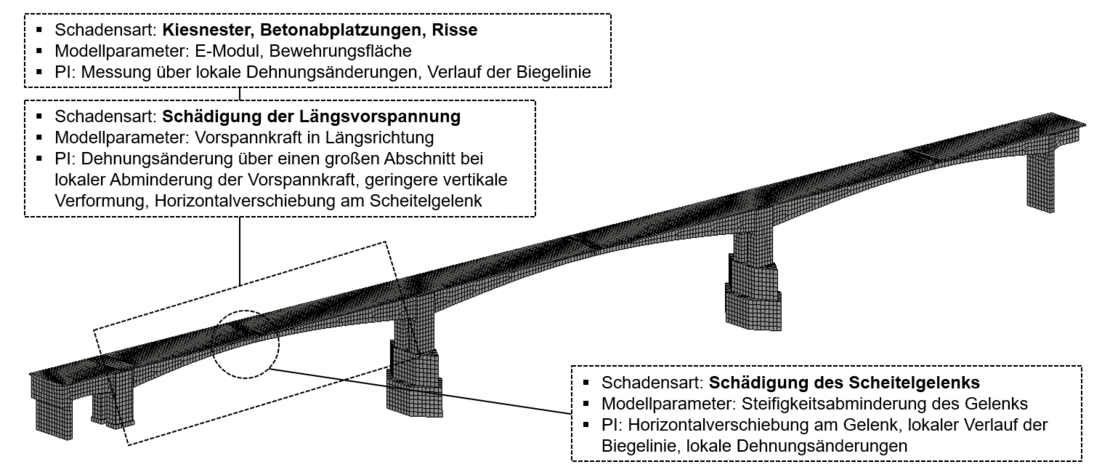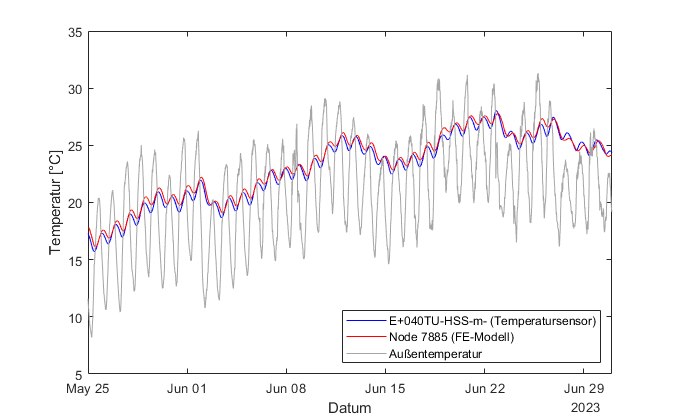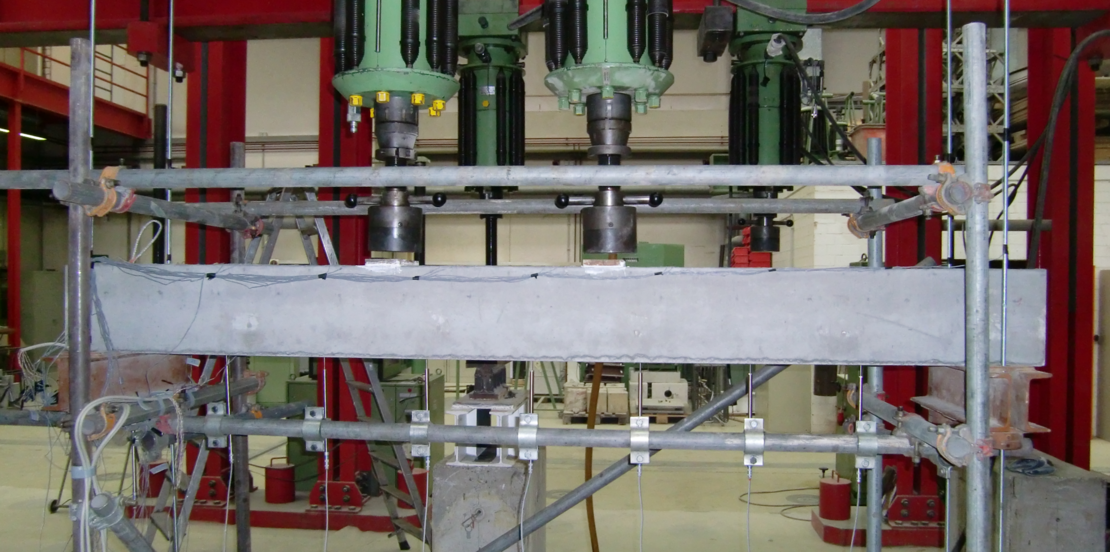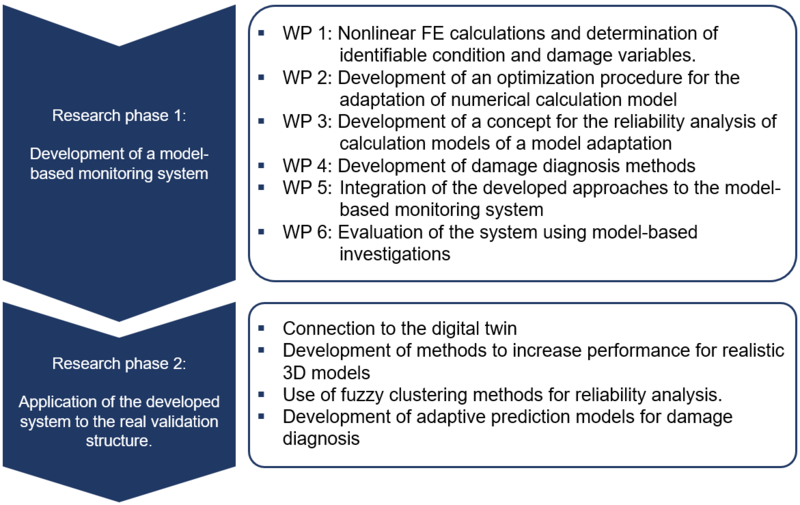Continuous monitoring of structures with model-based damage detection using nonlinear model fitting and artificial intelligence methods
The objective, proper assessment of the condition of structures and the early detection of the type, location and cause of damage represent the key aspects in structural health monitoring. Automated monitoring systems that continuously diagnose the behavior and condition of structures are becoming increasingly important. Non-destructive testing methods based on measurements and computational analysis are particularly useful in structural health monitoring. Currently, however, validated approaches to automated continuous monitoring of global structural health and detection of damage to massive structures face significant challenges.
The incorporation of automated monitoring systems enables objective and continuous recording of the structural condition. Thus, on the one hand, damages can be detected and evaluated promptly, and on the other hand, the aging process of the structure can be documented continuously. In the course of the priority project SPP 100+, the "Nibelungenbrücke" in Worms serves here as a validation structure for the development of an overall approach for the automated condition monitoring of highly stressed solid structures. The condition of the structure is to be described by reliably indicating the location and extent of any damage detected. The approach includes damage detection based on nonlinear model adaptation and artificial intelligence methods.
As part of the nonlinear FE calculations, sensitivity studies are performed to determine the identifiable condition and damage parameters, and the monitoring concept is prepared for the second phase of research. Due to the inverse problem of model adaptation, the uniqueness of solutions will be analyzed and evaluated. For the implementation, different methods of artificial intelligence are to be combined: The optimization task to be solved in the course of nonlinear model adaptation is highly complex.
The considered models can have a different number of degrees of freedom, different loads as well as several damage locations. Based on evolutionary algorithms, an optimization procedure is to be developed and used to find solutions in model adaptation. Since these optimization methods usually do not lead to a unique solution, clustering methods for the description of the obtained solutions will be investigated to increase the reliability. Here, a measurement point is assigned to a numerical computational model whose system component reliably describes the structural condition. Damage diagnosis is then performed by comparing the system states of different measurement time points. The concept of automated damage diagnosis developed in research phase 1 will be applied to the real validation structure in the second research phase.
Project Milestones within the SPP Framework
Im Rahmen des Teilprojektes C05 (Projektnummer: 501496870) soll ein Konzept auf Basis einer nichtlinearen Modelladaption und Methoden der Künstlichen Intelligenz zur automatisierten Zustandsüberwachung hoch beanspruchter Massivbauwerke entwickelt werden. Ein Demonstrator-Bauwerk, die Nibelungenbrücke in Worms, dient hierbei zur Validierung des entwickelten Ansatzes.
Der entwickelte hybride Algorithmus umfasst neben genetischen Algorithmen (GA) zur Adaption eines Finite Elemente (FE) Modells an das physikalische Bauwerk und eines Ersatzmodells zur effizienten Approximation der numerischen Reaktionsgrößen auch autoassoziative künstliche neuronale Netzwerkencoder (KNN-Autoencoder) zur Steigerung der Zuverlässigkeit des Ansatzes. Im Folgenden werden die wichtigsten Meilensteine und Highlights kurz zusammengefasst:
Meilenstein 1: Entwicklung eines FE-Modells der Nibelungenbrücke:
Zur detaillierten Repräsentation und möglichst exakten Modellierung von Schädigungen wurde ein parametrisiertes FE-Modell des Demonstrator-Bauwerks mit insgesamt 713620 Knoten an 34670 Volumenelementen entwickelt (Abbildung 1) [1]. Die Berechnung berücksichtigt neben geometrischen Nichtlinearitäten auch das nichtlineare Materialverhalten von Beton. Um eine korrekte Approximation der Reaktionen des Bauwerks durch das Modell zu ermöglichen, wurde das ungeschädigte Initial-Modell mit den am Bauwerk mittels des installierten Monitoringsystems gemessenen Reaktionen verglichen. In einer ersten Validierung wurden die gemessenen Temperatureinflüsse auf das Bauwerk als Lastfall auf das Modell angesetzt und die numerisch simulierten Betonteiltemperaturen mit den gemessenen Bauteiltemperaturen verglichen (siehe Abbildung 2). Das entwickelte FE-Modell und die generierten Daten wurden den anderen Teilprojekten des SPPs zur Verfügung gestellt.


Milestone 2: Development of a Model-Based Damage Detection Approach
The proposed concept [2,3] integrates GA [4] and ANN autoencoders to adapt the FE model to the actual structure. To validate the approach, various damage scenarios were defined and simulated using the developed methodology. In order to facilitate integration into a live monitoring environment, the computationally intensive FE model was replaced with a surrogate model trained on data from prior sensitivity analyses [5]. Damage detection is achieved by comparing the system parameters identified by the FE model across different measurement time steps. The approach successfully adapted the FE model to various damage scenarios [6], enabling accurate identification of both the time and location of damage occurrence [7].
Milestone 3: Detection of Damage of a Reinforced Concrete Beam
To evaluate the applicability of the approach using real measurement data from structural components, a reinforced concrete beam (Figure 3) was cast and instrumented with sensors. The lower longitudinal reinforcement was subsequently subjected to targeted damage. Using the approach developed in Milestone 2, the load location and intensity, as well as the damage location and severity, were reliably identified.

Ongoing Work in Research Phase 1 (until 09/2025) and Outlook for Research Phase 2:
Further validation of the proposed approach is planned under real-world conditions using the experimental bridge “openLAB” as part of the IDA-KI project, funded by the German Federal Ministry for Digital and Transport (BMDV). Initial validations of the initial model (Figure 4), using measurement data from July 16, 2024, and May 6, 2025, demonstrated a high degree of agreement between measured and simulated structural responses. To support broader use within the priority program (SPP), the model will be further refined and adapted based on additional measurement data before being made available to other subprojects.

References:
[1] Sprenger, B., Schnellenbach-Held, M.: Schadensmodellierung mittels nichtlinearer FE-Simulationen zur Bauwerksüberwachung im Rahmen eines Digitalen Zwillings. In: Oesterle, B., Bögle, A. Weber, W., Striefler, L. (Hrsg.) „Baustatik – Baupraxis 15“. Technische Universität Hamburg, 2024, S. 517-524; https://www.bb15.baustatik-baupraxis.de/Programm/program_presentation.php?id=14
[2] Becks, H., Lippold, L., Winkler, P., Moeller, M., Rohrer, M., Leusmann, T., Anton, D., Sprenger, B., Kähler, P., Rudenko, I., Andrés Arcones, D., Koutsourelakis, P., Unger, J. F., Weiser, M., Petryna, Y., Schnellenbach-Held, M., Lowke, D., Wessels, H., Lenzen, A., Zabel, V., Könke, C., Claßen, M., Hegger, J.: Neuartige Konzepte für die Zustandsüberwachung und -analyse von Brückenbauwerken – Einblicke in das Forschungsvorhaben SPP100. Bauingenieur, Heft 10/2024, S, 327-338; https://doi.org/10.37544/0005-6650-2024-10-63
[3] Steiner, D., Sprenger, B.: Moderne Konzepte im Massivbau – über Potenziale von Methoden der künstlichen Intelligenz. Bautechnik 100 (2023), Heft 6, S. 344 - 350; https://doi.org/10.1002/bate.202300034
[4] Guntermann, L., Sprenger, B.: Entwicklung eines Optimierungsverfahrens zur Strukturidentifikation von Brückenbauwerken. In: Stührenberg, J., Al-Zuriqat, T., Chillón Geck, C. (Hrsg.): „Tagungsband des 35. Forum Bauinformatik 2024“, Technische Universität Hamburg, 2024, S. 497-504; https://doi.org/10.15480/882.13510
[5] Sprenger, B., Schnellenbach-Held, M.: Sensitivity Analysis of Model Parameters in a Nonlinear Model-Updating Approach for Prestressed Concrete Bridges. In: Proceedings of the 11th European Workshop on Structural Health Monitoring (EWSHM 2024), June 2024, Potsdam; https://www.ndt.net/article/ewshm2024/papers/157_manuscript.pdf
[6] Schnellenbach-Held, M.; Sprenger, B.; Otto, M.: A Nonlinear Surrogate-Based Finite Element Model Updating Approach for Prestressed Concrete Bridges. Structural Engineering International, Special Issue, 2025 [accepted]. https://doi.org/10.1080/10168664.2025.2487431
[7] Schnellenbach-Held, M; Sprenger, B.: Automated Damage Detection in a Nonlinear Model Updating Approach for Concrete Bridges. In: Proceedings of the fib Symposium 2025, 2025 [accepted]
Contact
Publications
Peer-Reviewed Journal Paper
Becks, H., Lippold, L., Winkler, P., Moeller, M., Rohrer, M., Leusmann, T., Anton, D., Sprenger, B., Kähler, P., Rudenko, I., Arcones, D. A., Koutsourelakis, P.-S., Unger, J. F., Weiser, M., Petryna, Y., Schnellenbach-Held, M., Lowke, D., Wessels, H., Lenzen, A.,…Hegger, J. (2024). Neuartige Konzepte für die Zustandsüberwachung und -analyse von Brückenbauwerken – Einblicke in das Forschungsvorhaben SPP100+/Novel Concepts for the Condition Monitoring and Analysis of Bridge Structures – Insights into the SPP100+ Research Project. Bauingenieur, 99(10), 327-338. doi.org/10.37544/0005-6650-2024-10-63
Guntermann, L.; Sprenger, B.: Schadensdetektion an Brückenbauwerken durch FE-Modelladaption mittels Evolutionärer Algorithmen. in Böhmer, Heike et al.(2025): VHV-Bauschadenbericht 2024/25 Tiefbau und Infrastruktur. Fraunhofer IRB Verlag, URL: https://bauforschung.de/downloads-oeffentlich/ [accepted]
Schnellenbach-Held, M.; Sprenger, B.; Otto, M.: A Nonlinear Surrogate-Based Finite Element Model Updating Approach for Prestressed Concrete Bridges. Structural Engineering International, Special Issue, 2025 [accepted]. https://doi.org/10.1080/10168664.2025.2487431
Conferences and other publications
Sprenger, B.; Schnellenbach-Held, M.: Schadensmodellierung mittels nichtlinearer FE-Simulationen zur Bauwerksüberwachung im Rahmen eines Digitalen Zwillings. In: Oesterle, B., Bögle, A. Weber, W., Striefler, L. (Hrsg.) „Baustatik – Baupraxis 15“. Technische Universität Hamburg, 2024, S. 517-524; https://www.bb15.baustatik-baupraxis.de/Programm/program_presentation.php?id=14
Sprenger, B.; Schnellenbach-Held, M.: Sensitivity Analysis of Model Parameters in a Nonlinear Model-Updating Approach for Prestressed Concrete Bridges. In: Proceedings of the 11th European Workshop on Structural Health Monitoring (EWSHM 2024), June 2024, Potsdam; https://www.ndt.net/article/ewshm2024/papers/157_manuscript.pdf
Guntermann, L.; Sprenger, B.: Entwicklung eines Optimierungsverfahrens zur Strukturidentifikation von Brückenbauwerken. In: 35. Forum Bauinformatik 2024, 2024.
Schnellenbach-Held, M; Sprenger, B.: Automated Damage Detection in a Nonlinear Model Updating Approach for Concrete Bridges. In: Proceedings of the fib Symposium 2025, 2025 [accepted]






